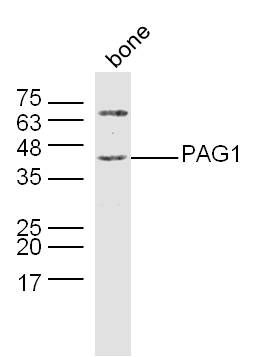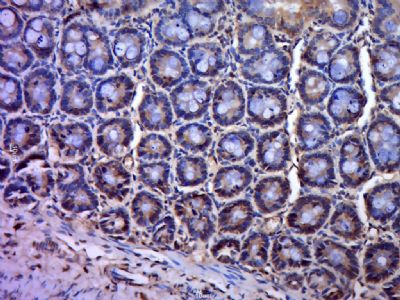PAG1 Polyclonal Antibody
Purified Rabbit Polyclonal Antibody (Pab)
- SPECIFICATION
- CITATIONS
- PROTOCOLS
- BACKGROUND

Application
| WB, IHC-P, IHC-F, IF, ICC, E |
|---|---|
| Primary Accession | Q9NWQ8 |
| Reactivity | Rat, Dog |
| Host | Rabbit |
| Clonality | Polyclonal |
| Calculated MW | 47 KDa |
| Physical State | Liquid |
| Immunogen | KLH conjugated synthetic peptide derived from human PAG1 |
| Epitope Specificity | 331-432/432 |
| Isotype | IgG |
| Purity | affinity purified by Protein A |
| Buffer | 0.01M TBS (pH7.4) with 1% BSA, 0.02% Proclin300 and 50% Glycerol. |
| SUBCELLULAR LOCATION | Cell membrane. Present in lipid rafts. |
| Post-translational modifications | Palmitoylated. Phosphorylated by FYN on Tyr-317 in resting T-cells; which promotes interaction with CSK. Dephosphorylated by PTPRC/CD45 upon TCR activation; which leads to CSK dissociation. May also be dephosphorylated by PTPN11. Hyperphosphorylated in mast cells upon FCER1 activation. |
| Important Note | This product as supplied is intended for research use only, not for use in human, therapeutic or diagnostic applications. |
| Background Descriptions | The Src family of protein tyrosine kinases (Src-PTKs) is important in the regulation of growth and differentiation of eukaryotic cells. The activity of Src-PTKs in cells of different types is negatively controlled by Csk. Csk binding protein (Cbp), also designated phosphoprotein associated with glycosphingo-lipid-enriched microdomains (GEMs) or PAG, is a ubiquitously expressed transmembrane phosphoprotein that binds specifically to the SH2 domain of Csk. Cbp is involved in the membrane localization of Csk and in Csk-mediated inhibition of c-Src. In the plasma membrane, Cbp is exclusively localized in the GM1 ganglioside-enriched detergent-insoluble membrane domain, which is important in receptor-mediated signaling. Cbp is a component of the regulatory mechanism controlling the activity of membrane-associated Src-PTKs. |
| Gene ID | 55824 |
|---|---|
| Other Names | Phosphoprotein associated with glycosphingolipid-enriched microdomains 1, Csk-binding protein, Transmembrane adapter protein PAG, Transmembrane phosphoprotein Cbp, PAG1, CBP, PAG |
| Target/Specificity | Ubiquitously expressed. Present in germinal center B-cells, plasma cells, T-cells, monocytes and platelets (at protein level). |
| Dilution | WB=1:500-2000,IHC-P=1:100-500,IHC-F=1:100-500,ICC=1:100-500,IF=1:100-500,ELISA=1:5000-10000 |
| Storage | Store at -20 ℃ for one year. Avoid repeated freeze/thaw cycles. When reconstituted in sterile pH 7.4 0.01M PBS or diluent of antibody the antibody is stable for at least two weeks at 2-4 ℃. |
| Name | PAG1 |
|---|---|
| Synonyms | CBP, PAG |
| Function | Negatively regulates TCR (T-cell antigen receptor)-mediated signaling in T-cells and FCER1 (high affinity immunoglobulin epsilon receptor)-mediated signaling in mast cells. Promotes CSK activation and recruitment to lipid rafts, which results in LCK inhibition. Inhibits immunological synapse formation by preventing dynamic arrangement of lipid raft proteins. May be involved in cell adhesion signaling. |
| Cellular Location | Cell membrane; Single-pass type III membrane protein Note=Present in lipid rafts |
| Tissue Location | Ubiquitously expressed. Present in germinal center B-cells, plasma cells, T-cells, monocytes and platelets (at protein level). |

Thousands of laboratories across the world have published research that depended on the performance of antibodies from Abcepta to advance their research. Check out links to articles that cite our products in major peer-reviewed journals, organized by research category.
info@abcepta.com, and receive a free "I Love Antibodies" mug.
Provided below are standard protocols that you may find useful for product applications.
If you have used an Abcepta product and would like to share how it has performed, please click on the "Submit Review" button and provide the requested information. Our staff will examine and post your review and contact you if needed.
If you have any additional inquiries please email technical services at tech@abcepta.com.













 Foundational characteristics of cancer include proliferation, angiogenesis, migration, evasion of apoptosis, and cellular immortality. Find key markers for these cellular processes and antibodies to detect them.
Foundational characteristics of cancer include proliferation, angiogenesis, migration, evasion of apoptosis, and cellular immortality. Find key markers for these cellular processes and antibodies to detect them. The SUMOplot™ Analysis Program predicts and scores sumoylation sites in your protein. SUMOylation is a post-translational modification involved in various cellular processes, such as nuclear-cytosolic transport, transcriptional regulation, apoptosis, protein stability, response to stress, and progression through the cell cycle.
The SUMOplot™ Analysis Program predicts and scores sumoylation sites in your protein. SUMOylation is a post-translational modification involved in various cellular processes, such as nuclear-cytosolic transport, transcriptional regulation, apoptosis, protein stability, response to stress, and progression through the cell cycle. The Autophagy Receptor Motif Plotter predicts and scores autophagy receptor binding sites in your protein. Identifying proteins connected to this pathway is critical to understanding the role of autophagy in physiological as well as pathological processes such as development, differentiation, neurodegenerative diseases, stress, infection, and cancer.
The Autophagy Receptor Motif Plotter predicts and scores autophagy receptor binding sites in your protein. Identifying proteins connected to this pathway is critical to understanding the role of autophagy in physiological as well as pathological processes such as development, differentiation, neurodegenerative diseases, stress, infection, and cancer.



